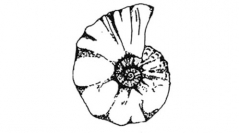

 Comptes Rendus Palevol
2 (6-7) - Pages 535-546
Comptes Rendus Palevol
2 (6-7) - Pages 535-546The Nigericeras gadeni ontogenesis (Saharian Upper Cretaceous) is characterized by three ornamental stages: multi-tuberculate inner-whorls, ombilical bi-tuberculate medium-whorls, then finally smooth adult stage. Ontogenetic Heterochonies account for their adult variability, which extends between both paedomorphic (thick/ornamented) morphotype, and peramorphic (thin/smooth) morphotype. That species may take root in the older Pseudocalycoceras. A peramorphocline characterizes the evolution of these ammonites and their younger relatives, leading to different Nigerian and Nigerien, highly compressed taxa. Such morphologies seem to be related to shallow-water palaeo-environments. The general transgressive context leads to the progressive scarcity of their supposed ecological niches.
heterochronies, peramorphosis, Ammonitina, Upper Cretaceous, Sahara